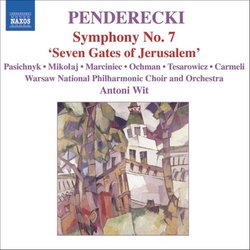| All Artists: Krzysztof Penderecki, Antoni Wit, Warsaw National Philharmonic Orchestra, Olga Pasichnyk, Aga Mikolaj, Ewa Marciniec, Wieslaw Ochman, Romuald Tesarowicz, Boris Carmeli Title: Penderecki - Symphony No. 7 'Seven Gates of Jerusalem' Members Wishing: 1 Total Copies: 0 Label: Naxos Original Release Date: 1/1/2006 Re-Release Date: 10/31/2006 Genre: Classical Styles: Historical Periods, Modern, 20th, & 21st Century, Symphonies Number of Discs: 1 SwapaCD Credits: 1 UPC: 747313276622 |
Search - Krzysztof Penderecki, Antoni Wit, Warsaw National Philharmonic Orchestra :: Penderecki - Symphony No. 7 'Seven Gates of Jerusalem'
 | Krzysztof Penderecki, Antoni Wit, Warsaw National Philharmonic Orchestra Penderecki - Symphony No. 7 'Seven Gates of Jerusalem' Genre: Classical
|
Larger Image |
CD DetailsSimilar CDs |
CD ReviewsPenderecki's Symphony to Jerusalem Robin Friedman | Washington, D.C. United States | 04/21/2008 (5 out of 5 stars) "The Polish composer Krzystof Penderecki (b. 1933) initially gained fame as a composer of avant garde, atonal, and difficult music. In common with many other composers, such as the American George Rochberg, his style changed over the years from modernism to a more traditional, late romantic style. A devout Catholic, Penderecki has composed many works with religious themes. Penderecki's Symphony no. 7, "Seven Gates of Jerusalem" is a large-scale romantic composition of immediate appeal. It is a powerful religious work of over an hour's duration scored for orchestra, five singers, a narrator, and chorus. It is beautifully rendered on this budget-priced Naxos CD by the Warsaw National Phiharmonic Orchestra conducted by Antoni Wit. Wit is in the process of recording Penderecki's symphonies and orchestral compositions for Naxos. Penderecki composed this symphony in 1996 to celebrate the third millenium of Jerusalem and it was premiered in that city in 1997. Initially conceived as an oratorio, Penderecki subsequently decided to call the work a symphony. Chorus and soloists predominate from beginning to end. The work is in seven movements, each of which sets texts from the Psalms and Prophets that describe Jerusalem. The movement is in turns broad and powerful and quiet and intimate with large orchestral and choral passages alternating with passages for the soloists and for small ensembles. The movements likewise differ widely in scope with three lengthy movements, the first, fifth and seventh, interspersed with four shorter and generally quieter movements. Many of the themes of the work and the repetition of notes make use of the number 7 -- for the gates of Jerusalem (an eighth gate is said to wait until the time of the Messiah). The work opens with a majestic setting of Psalm 47's "Great is the Lord and highly to be praised/ in the city of God on our holy mountain." There is a middle section for the soloists after which the opening material returns in force. The second movement is a short meditation for soloists on the text "If I forget thee, O Jerusalem, let my right hand be given to oblivion." (Psalm 136) This text returns as well in the fourth movement. The third movement is unique in that it is in an unaccompanied, chant-like style setting the text "Out of the depths I have called to you Lord/Lord, hear my voice"from Psalm 129. The lengthy fifth movement is a song of praise with percussion, brass, and bells with alternating powerful and reflective sections setting texts from Psalms and several Prophets. The Sixth movement features a speaker reciting in Hebrew verses from Ezekiel to the accompaniment of solemn brass. The finale has the character of an enormous summation, beginning with a setting of Jerimiah's "Thus saith the Lord/Lo I give you the way of Life and the way of Death." This is intense music that works to a large climactic conclusion. The highlights of this work are the magnificent opening phrase for brass and chorus, the intimate, archaic third movement, and especially the recital passages of Boris Carmeli in the climactic sixth movement. The effect of this entire work, on initial hearing, is overwhelming and visceral. Those expecting highly modern, difficult music will not find it in this symphony. Instead, this is modern music of great immediacy and passion in the language of religious devotion. The texts are not included in the liner notes, but they are available on the Naxos website. Robin Friedman" An early classic of the 21st century Robin Friedman | 06/16/2008 (5 out of 5 stars) "I will not go on writing about the obvious, but I'll say this: This works matches the greatness of some of the monumental pieces of the 20th Century. I consider it up there with Shostakovich's symphonies, and with some of the great choral works of all times." Symphony No. 7 Timothy | 06/22/2008 (5 out of 5 stars) "Penderecki has very quickly become my favorite composer. The first work I heard of his was his "Symphony No. 3". This symphony, though having a little bit a different texture, still holds the dark quality in sound that is so characteristic of Penderecki. What adds to the dark sound is the added choral part. This piece also has a text to be sung by a choir.
This CD has made it into my Top 10!" |

 Track Listings (7) - Disc #1
Track Listings (7) - Disc #1

